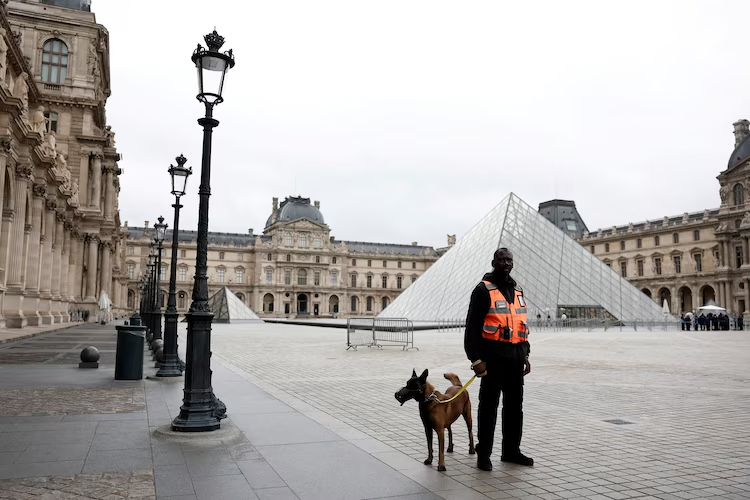The Louvre Heist Everyone’s Talking About and What It Says About Modern Security

Learn more about the details of the Louvre heist and what it indicates about the consequences of security gaps—even at the most prestigious sites in the world.
Everyone’s talking about it—the Louvre heist that sounds straight out of Ocean’s Eleven. On October 19th, 2025, in broad daylight, a crew pulled off one of the boldest museum robberies in recent history. These thieves walked away with priceless jewels while the world watched in disbelief. The story has all the ingredients of a thriller—elegance, precision, and a touch of chaos. From art lovers to security pros, one big question lingers: how does something like this still happen in 2025?
What Happened at the Louvre
It was 9:30 on a quiet Monday morning in Paris, and the Louvre had just opened to visitors. Within minutes, one of the world’s most famous museums became the scene of a high-stakes heist.
Disguised as maintenance workers, the thieves arrived with a mechanical lift on the back of a truck, according to the lead prosecutor in the case. Without catching the attention of passing people or security, the crew raised themselves to the upper floor and cut through a window using power tools. Gaining access to the Galerie d’Apollon, the thieves then broke through the glass display case and grabbed several pieces of Napoleonic-era jewelry studded with thousands of diamonds.
Their exit was as seamless as their entry. The crew descended the same lift they came in on, hopped onto electric scooters waiting outside, and disappeared into the Paris streets. From start to finish, the entire operation, from entry, theft, and getaway, took roughly seven minutes.
Authorities believe the thieves will likely break down the jewelry to sell the diamonds and precious metals without suspicion. The stolen jewelry is believed to be worth around $102 million. An international manhunt is now underway, with investigators analyzing DNA and security footage to identify the suspects. Across France, people are reeling, heartbroken that some of their most beloved cultural treasures were stolen so brazenly.
How Did This Happen?
The world is in collective shock, wondering—how did this happen? How did one of the most famous museums in the world experience a heist in broad daylight? And how did it happen so easily?
As investigators piece together the timeline, the answers seem to point to a mix of outdated security and blind spots in coverage. Many of the Louvre’s galleries, including the Galerie d’Apollon where the jewels were displayed, had limited CCTV surveillance. Some rooms are without cameras altogether, others only equipped with aging video systems that offer little help after the fact.
Louvre president Laurence des Cars admitted that the museum’s perimeter security has long been a weak point, saying, “The weakness of the Louvre is its perimeter security, which has been a problem for a long time … certainly due to underinvestment.” She named the incident a “terrible failure” and calls for better security at such a historic museum and monument.
Even the alarm systems failed to provide any kind of deterrent. Reports indicate that alarms didn’t sound when the thieves broke in—only as they were leaving. These factors resulted in a perfectly timed, almost cinematic robbery that exposed serious vulnerabilities in one of the most iconic settings in the world. It has sparked global conversations about how even high-profile sites can fall behind in modern security.
If LVT Had Been on the Scene
We like to think that if LiveView Technologies (LVT) had been on the scene, things might have unfolded a little differently. The Louvre’s vulnerabilities, from weak perimeter coverage to delayed alarms, are the exact problems LVT security solutions were built to solve.
LVT’s AI-powered analytics are trained to recognize irregularities in behavior and movement. They effortlessly spot things like trespassers, suspicious behavior, or the setup of a lift truck where it doesn’t belong. Anything out of the ordinary pattern will be flagged. Rather than relying on motion sensors or reactive alarms, LVT’s systems detect, alert, and deter in real time, long before damage is done.
Our units are also designed for perimeter protection. They provide a visible deterrent that sends a powerful message that someone is watching. While this message is strong, our units don’t take up much space, which is a big advantage for historic or high-traffic sites where security has to blend in, not stand out.
And when something unexpected does happen, LVT’s high-resolution PTZ cameras (pan, tilt, zoom) can track every detail, with resolution far beyond what low-quality CCTV might capture. Paired with thermal imaging that detects heat signatures even in low light or obscured areas, these systems make it far harder for intruders to slip by unnoticed.
Because while the Louvre heist feels like something out of a movie, it’s a real reminder of how fast threats can evolve —and the difference the right technology can make.
Lessons from the Louvre
Art may imitate life, but when it comes to security, no one wants a real-life heist. This unfortunate crime is a reminder that even the most iconic places can face security gaps. Smarter, up-to-date response systems like LVT’s help make sure the next big museum story is about the art—not the theft.


.avif)
